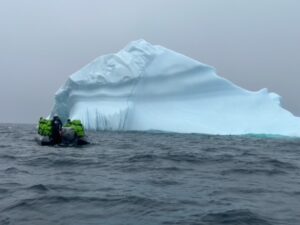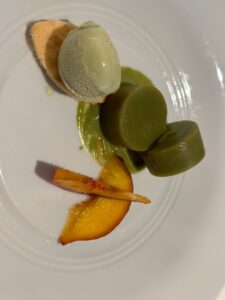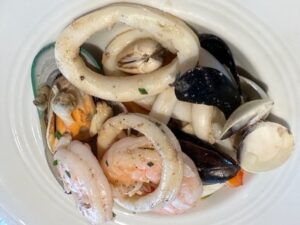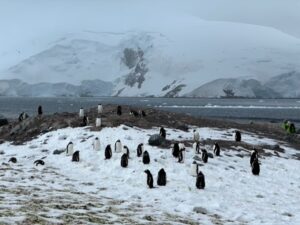I recently participated in a 9-night expedition to Antarctica with Atlas Ocean Voyages, a luxury expedition cruise line. The trip was absolutely magical. I had wanted to experience something totally different and Antarctica and Atlas delivered big time.
Let me put it this way. What is the superlative of wow? And if you want to be wowed on a daily basis, I recommend Antarctica. It’s like stepping into another world – another universe – where the penguins have the right of way.
The white continent, as it is called, is astonishing in its beauty and absence of civilization. I was awed by the landscape and the wildlife as I cruised in zodiacs sometimes next to whales and penguins, through the Southern Ocean filled with gorgeous 40 foot icebergs resembling ice sculptures.
Jus t imagine: no civilization. I don’t just mean remote: I mean absolutely nobody. A continent bigger than the United States and Mexico combined and no one is in sight. No delis, no drug stores, no medieval centers, not even one charming, small village. Yes, there are some research science bases “somewhere”, but not in your eye’s view. Next to landing on the moon, I can’t imagine anything so totally “other worldly”.
t imagine: no civilization. I don’t just mean remote: I mean absolutely nobody. A continent bigger than the United States and Mexico combined and no one is in sight. No delis, no drug stores, no medieval centers, not even one charming, small village. Yes, there are some research science bases “somewhere”, but not in your eye’s view. Next to landing on the moon, I can’t imagine anything so totally “other worldly”.
While Antarctica was probably the coolest place I’ve ever been, it actually was not the coldest. In the winter it can be “the most inhospitable place on earth” due to severe weather, winds and below freezing temperatures. But that’s not the case during the summer months which start in November and end in March. I was there in February and the temperatures are typically in the low 30’s and can be colder. But we had some days in the 40’s and sometimes it was actually colder in New York.
Getting there was fairly easy thanks to Atlas Ocean Voyages. I flew to Buenos Aires and from there took a charter flight arranged by Atlas direct to Ushuaia, the town at the southernmost point of Argentina that bills itself as “the end of the world”.
Next, I boarded The World Traveler, Atlas’s new ship that was launched in November 2022. It is one of two ships that Atlas operates for its luxury ocean cruises to Antarctica, the Arctic, and various destinations in the Mediterranean. Their second ship, The World Navigator, is only a year older.
From the minute I set foot on board, I was enthralled. The ship was gorgeous and pristine. After being greeted with cocktails and hors d’oeuvres, we were escorted to our staterooms where I met the lovely steward in charge of my room who took care of every possible need. The room was fabulous and ingeniously designed. Imagine having enough closet space on a ship! This is something New Yorkers talk about – and complain about – all the time. Another bonus was an ample sitting area with a sofa, 2 chairs, and a desk. Not to mention a mini fridge packed with whatever beverages (including liquor) you had pre-ordered before the trip. All included and replenished as needed. A button on the wall operated the floor to ceiling window that could come down when you wanted fresh air or to take a picture without having to shoot through the glass.
A welcome briefing introduced us to the expedition team and whet our appetite for what to expect during the voyage. We were advised to put on the motion sickness patch “now” if we had brought them. So, I ran to my room, applied the patch behind my ear and got mentally prepared for the Drake Passage. After leaving Ushuaia, we would first pass through the calm waters of the Beagle Channel in Terra del Fuego and sometime around midnight or 1 am, enter the infamous Drake.
The Drake, as it is affectionately called, is hard to predict because weather in that part of the world can change fast. You can have a rough passage with high waves and high nausea (known as “the Drake Shake”) or a pretty smooth passage (“the Drake Lake”). Or something in between. On the way down, we had mild waves with mild rocking. And on the return trip, we had a Drake Lake.
In full disclosure, I had been dreading the Drake and arrived ultra-prepared with every remedy known to man – the prescription patch as well as Dramamine and wrist bands on stand by. As it turned out, I only used the patch and didn’t need to go to plan B.
The first day and a half were spent at sea. And, I was not at all bored! There was always so much to do. The fitness center was open with bikes and treadmills looking out at the extraordinary landscape. I attempted the walking track on the top deck (12 times around is a mile), but the winds were too strong. So, I headed to the spa instead and spent time in the sauna and in a quiet room on lounge chairs facing the sea. I also booked a massage and facial for later that week.
Once we were out of the Drake passage, the heated swimming pool and hot tub on the top deck were opened. I wasn’t going to pass up the opportunity to go swimming in Antarctica. Jumping into a pool in 32 degree weather was just another unusual thing to do on this journey filled with daily “unusuals”.
While most passengers tended to remain inside during the crossing, a group gathering at a huge window would soon become a familiar occurrence and a signal that wildlife activity was happening next to the ship. There were windows everywhere. You could either dash to a window or an outside deck where you could watch the orcas and whales bobbing in and out of the water.
Daily lectures presented by the ship’s expedition team in the Vasco de Gama auditorium were another interesting and thought-provoking way to spend time. Informative and fascinating, the briefings kept me totally engaged. The team included very knowledgeable ornithologists, naturalists, marine biologists, polar meteorologists, and expedition & kayak guides.
They covered everything: wildlife (the various kinds of penguins, birds, whales, orcas, and seals), the landscape and geography (glaciers, icebergs, volcanology, the ocean) and the explorers who discovered this amazing continent. For example, did you know that Antarctica has more orcas than any place on earth? And that Albatross birds can fly more than 10,000 miles across the world without stopping? No wonder so much drone technology is inspired by these awesome birds known as the ballerinas of the sky.
Perhaps the lecture that most intrigued me as a journalist focused on who owns Antarctica. Short answer: no one.
Of course, I have to mention the food on board. The quantity, variety and quality were all amazing. Not every dish was gourmet or on the level of a Michelin rating, but the chef did an amazing job for approximately 136 passengers plus crew and expedition team. And all the breads and pastries were freshly-baked!
Even the breakfast choices were vast. All kinds of eggs, omelettes, pancakes, bagels with salmon, and daily specials which might include tapioca pancakes with chia or spinach and cheese frittatas. You could eat in the dining room or order room service. The lunch buffet ranged from a variety of salads to roast beef cut while you watched, roast duck, chicken dishes, grilled turbot or salmon en croute, platters of cheeses and roasted vegetables, and a daily changing pasta station. One of my favorites was the mixed seafood paella.
dishes, grilled turbot or salmon en croute, platters of cheeses and roasted vegetables, and a daily changing pasta station. One of my favorites was the mixed seafood paella.
Dinner was usually served by waiters. And there were several menus to choose from with themes spanning the globe: French, Japanese, Italian, Asian Fusion, Brazilian, Ara bic, and Classic Fare featuring Argentinian beef. One night there was an outstanding rack of lamb with mashed potatoes. The Japanese menu offered wakame salad, teriyaki glazed red snapper and a green tea mochi desert with sake-poached peaches that was delicious. Another night, I had a beautifully-presented passion fruit mousse from the Brazilian menu. On Valentine’s Day, a chocolate soufflé with hazelnut sauce was topped with a red heart.
bic, and Classic Fare featuring Argentinian beef. One night there was an outstanding rack of lamb with mashed potatoes. The Japanese menu offered wakame salad, teriyaki glazed red snapper and a green tea mochi desert with sake-poached peaches that was delicious. Another night, I had a beautifully-presented passion fruit mousse from the Brazilian menu. On Valentine’s Day, a chocolate soufflé with hazelnut sauce was topped with a red heart.
All the wine and alcohol on board were included. Every evening before dinner the bartender in the Atlas lounge offered a special cocktail of the day with combinations that were always fun to try. Two favorites were the Passion Fruit Martini and the Elderblanco Spritz.
If you got hungry between meals (which would be hard to believe), you could head to Paula’s Pantry where smoothies, energy shots, pastries, sandwiches and salads were available all day long. For a late afternoon snack after zodiac landings, pizza or sweet surprises such as crepes with chocolate sauce would suddenly appear.
Because we made such good time going through the Drake, our first landing on shore was the afternoon of the second day at sea. The anticipation was building and the excitement palpable. First, a trip to the mud room where we got fitted for our ultra-warm parkas (a stylish lime green and yours to keep) and rubber boots (on loan for the duration of the journey).
Our first stop was the South Shetland Islands which are Antarctic islands just north of the peninsula. So, into our waterproof pants, boots, parkas, hats and gloves and by groups of 10, we descended a staircase to zodiacs to take us to our first landing at Half Moon Island. And our first sighting of Penguins! Lots of chinstrap penguins waddling on the beach near elephant seals that lay moulting on the rocks.
Super adorable and incredibly charming, the penguins shuffled across the terrain, sometimes hopping over the rocks and sometimes stopping mid-path as if deciding which direction to go in. It was really cool when they stopped and stared directly at you. So many photo ops and so many smiles. As we had learned in one of the lectures, penguins are really creatures of the sea. We had our first look at these olympic swimmers and divers while we were in the zodiac heading to shore. We were in The Southern Ocean and the penguins were on a mission: to get food for their young.
After we returned to the ship and passed through the disinfecting platform (a machine that scrubs your boots as you walk onto the ship), we were always met with knowing smiles and warm drinks.
Next, we sailed to the Antarctic peninsula which would be our home for the next 5 days filled with zodiac excursions and shore landings. Only one landing had to be canceled due to weather. But the ship moved on to another location and we did have an afternoon landing where we were entertained by hundreds of gentoo penguins (maybe thousands; crowd count is not my strong suit) and more seals molting on the beach.
I was beginning to sense the rhythm of the expedition. Weather permitting, there would be 2 zodiac explorations or landings each day – one in the morning and one in the afternoon at another location. The ship would keep moving during lunch. In the early evening after cocktails, there would be a briefing to recap the day and discuss the next day’s adventure. After dinner, there was usually a movie or documentary. The Dome nightclub was open nightly for drinks. Our cruise director, an actor with a musical theater background, treated us to several delightful Cabaret performances in the Dome.
During the journey, we saw tons of gentoo and chinstrap penguins, elephant seals, fur seals, Weddell seals and leopard seals on land. And many different species of birds flying overhead. In zodiacs, we explored the Southern Ocean frequently entertained by humpback whales who played fairly close to the zodiac. Our kayak guides were very skilled at steering and maintaining a safe distance. Apparently, the Antarctic peninsula is the summer real estate for humpback whales. We also saw numerous orcas swimming nearby; fortunately they got the memo to maintain their distance.
Cruising past glaciers and among icebergs was incredibly exciting and beautiful. We saw an old ship wreck dating from 1915. The only other humans we saw were paddling-passengers from our ship who had signed up for special kayaking excursions.
When it came time to say goodbye to the penguins and seals, the ship headed back through the Drake Passage on our return to Ushuaia via Cape Horn. From the windows and observation decks we watched albatrosses, petrol birds, whales and orcas. And passengers were still excited to scream out: “orcas”. And we were all still excited to dash to a window or nearby deck to have yet another look.
We docked in Ushuaia the night before departing the ship and were able to spend an evening exploring this small town at the bottom of the world. Since I’ve been home, I find myself wondering almost on a daily basis: who will own -or fight over – Antarctica in the future?
